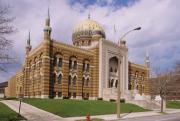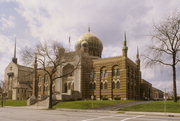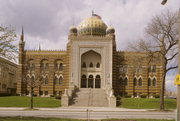Property Record
3000 W WISCONSIN AVE
Architecture and History Inventory
| Historic Name: | Tripoli Temple |
|---|---|
| Other Name: | TRIPOLI SHRINE |
| Contributing: | |
| Reference Number: | 17098 |
| Location (Address): | 3000 W WISCONSIN AVE |
|---|---|
| County: | Milwaukee |
| City: | Milwaukee |
| Township/Village: | |
| Unincorporated Community: | |
| Town: | |
| Range: | |
| Direction: | |
| Section: | |
| Quarter Section: | |
| Quarter/Quarter Section: |
| Year Built: | 1926 |
|---|---|
| Additions: | 1928 |
| Survey Date: | 1984 |
| Historic Use: | social recreational/fraternal hall |
| Architectural Style: | Exotic Revivals |
| Structural System: | |
| Wall Material: | Brick |
| Architect: | Clas, Shepherd & Clas |
| Other Buildings On Site: | |
| Demolished?: | No |
| Demolished Date: |
| National/State Register Listing Name: | Tripoli Temple |
|---|---|
| National Register Listing Date: | 1/16/1986 |
| State Register Listing Date: | 1/1/1989 |
| National Register Multiple Property Name: | Multiple Resources of West Side Area |
| Additional Information: | A 'site file' exists for this property. It contains additional information such as correspondence, newspaper clippings, or historical information. It is a public record and may be viewed in person at the State Historical Society, Division of Historic Preservation. Builder: Bentley Bros. ARCHITECTURAL STATEMENT: Description: One of the most unique club and fraternal buildings in Milwaukee, the Tripoli Temple was completed in 1928 to house the Shriners, the Ancient Arabic Order of the Nobels of the Mystic Shrine, a Masonic body. It was designed by the firm of Clas, Shepard and Clas, and built by Bentley Bros. (F). The tile work was crafted by U.F. Durner Co. (G). The exterior walls of the two-story rectangular structure were built of alternate rows of dark red and buff colored face brick. This horizontal banding is juxtaposed with the vertical arched recesses, two stories high, which extend across the facade. The recesses incorporate paired horseshoe-shaped window openings on the second story while the first story windows have pointed arches accented with cut stone. The projecting, three-bay entrance pavilion extends up beyond the second story and is covered with geometric and floral designs of bright colored faience tiles. Ornamental stone cresting enriches the parapet. A 30' diameter dome tops the entrance pavilion and is flanked by two small ornamental domes. All three domes are tile covered. Miniature minarets rise from the four corner buttresses. A monumental staircase, ornamented with a pair of recumbent camels, rises in three stages to the main entry. A porte cochere is located at the east elevation. Additions have been made to the rear, west and north end of the building but do not mar the otherwise intact main building. Interior meeting rooms, lounges, a drill room and aduitorium are not as lavishly ornamented as the exterior. Architectural/Engineering Significance: The Tripoli Temple is Milwaukee's supreme architectural oddity. Nothing like it is known to exist anywhere in Wisconsin. Built in the 1920s hey day of period revival fantasy architecture, Tripoli exhibits lavish materials, rich polychromy and skillful craftsmanship. The mosque embodies the oriental glamour, pageantry, exoticism and mystic spledor that the "Shrine" founders tried to capture in their ritual. For inspiration, the prestigious firm of Clas, Shepard and Clas (1913-1931) drew upon North African Moslem prototypes which were thought to best exemplify the Shrine ritual. HISTORICAL STATEMENT: The Ancient Arabic Order of the Nobels of the Mystic Shrine was founded in New York on August 13, 1870, by two Scottish Rite Masons, William J. Florence, a prominent actor, and Dr. Walter M. Fleming. On June 13, 1871, eleven Scottish and York Rite Masons were received into the new order, A.A.O.N.M.S. Mecca, the first formally organized Temple in the U.S., was established in New York City in 1872. The Shrine was founded for felowship and recreation. By 1980, the original 13 members had grown to over 950,000 in over 181 Temples throughout North America. A Shriner has attained the highest degree of Masonry, having completed either the York or Scottish Rite. The colorfully-staged rituals, parades and red fez make the Shriners the most identifiable of the Masonic groups. The Shrine's principle philanthropic activities are directed to the aid of handicapped or burn victims. The Shriners Hospital for Crippled Children was founded in 1921. This has been expanded to include 21 orthopedic and burn hospitals throughout North America. Parental membership in the Shriners is not required for care at these facilites. Milwaukee's Tripoli Temple traces its origins to the Medinah Temple of Chicago. Several Nobles from Medinah who lived in Milwaukee wanted to establish a temple here. A petition was made for a new temple in Wisconsin. It was to be known as Tripoli and have its headquarters in Milwaukee. Dispensation was granted on March 9, 1885 making Tripoli the 21st Shrine Temple of the A.A.O.N.M.S. The charter was granted on June 4, 1886. Titles of officers are Arabic in orgin. The entire body of officers is known as the Divan and serves as a board of directors. Milwaukee's Ancient Arabic Order, Nobles of the Mystic Shrine met initially as the same Masonic Temple on North Plankinton as did many of the city's other Masonic orders. It then moved to the Masonic Building formerly on the southeast corner of Jefferson and Wells, where it remained until 1922 when the builidng became an annex of the courthouse. From 1923 to 1927 the Shriners shared occupancy of the Scottish Rite Temple at the southeast corner of Van Buren and Wells Streets. In 1928 the Tripoli Temple moved into the quarters it occupies today at 3000 West Wisconsin Avenue. The site originally contained a large mansion and two carriage houses occupied by J. Oscar Ogden in the 1870s-1880s. From the 1890s through the mid-1920s, the residence was the home of the Hansen family, furriers in the Plankinton Arcade. The Shriners also acquired a residence to the east, fronting on West Wisconsin Avenue. The availability of such a large parcel would not have been possible in the heart of commerical downtown, but by that time, the large residences up and down West Wisconsin were giving way to apartment buildings or filling stations. The mosque-like structure which replaced the elegant Ogden Mansion resembles the Taj Mahal in massing and has been a highly visible city landmark ever since its completion. Designed by the firm of Clas, Shepard and Clas, it cost nearly a million dollars to construct. The Tripoli Temple is still active and currently has 31 official units, seven of which are based outside Milwaukee. Tripoli sponsored the estabishment of Zor Temple in Madison, much as Medinah had been its sponsor in 1885. Tripoli now has 28 chartered Shrine Clubs scattered throughout Wisconsin. It sponsors the annual Shrine Circus in Milwaukee and Green Bay, and sponsors the Midwest Shrine Football Game which benefits the Shrine Hospitals and burn institutes. Historical Significance: The Tripoli Temple is historically important as the first Shrine chapter in the State of Wisconsin. Coming just thirteen years after the first organized temple in New York City, Milwaukee's Temple was the 21st in the nation. From this beginning, Milwaukee's Tripoli sponsored the formation of Zor Temple in Madison and has chartered some 28 clubs throughout the state. One of the largest and most visible branches of Masonry, with colorful parades and red fezzes, the Tripoli sponsors the Annual Shrine Circus in Milwaukee and the Midwest Shrine Football Game. (B). The Tripoli Temple is one of the City's unique architectural forms. Known locally as the "Mosque" its design is influenced with Moorish and Indian elements. Its form is slightly reminiscent of the Taj Mahal in Agra, India. Of note is its rich facade of floral and geometric tiles, and polychromy masonry. |
|---|---|
| Bibliographic References: | A. Milwaukee City Building Permits. B. "A Story of Masonry and the Shrine. The World's Philanthrophy." Milwaukee: Tripoli Temple, 1980. Pp. 19, 31. C. "MASTER BUILDER", JULY 1926 PP. 12-13. D. MILWAUKEE HISTORIC BUILDINGS TOUR: WEST END, CITY OF MILWAUKEE DEPARTMENT OF CITY DEVELOPMENT, 1994. E. Milwaukee Daily Reporter 6/17/1998. Perrin. Milwaukee Landmarks, 46. G. Unidentified newspaper clipping 3/9/1939. Catalog of Architectural Works of Ferry and Clas, 1936. Spaces & Traces Open House Tour, Historic Milwaukee Inc., 2012. |
| Wisconsin Architecture and History Inventory, State Historic Preservation Office, Wisconsin Historical Society, Madison, Wisconsin |





